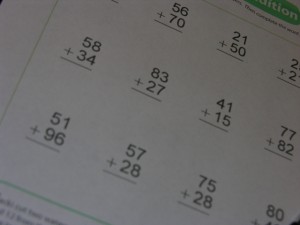It’s an exciting time when your child begins to explore some of the more complicated 2nd grade math skills. Addition with Regrouping is a concept that can be a bit tricky for children to pick up. As a parent, there are several things you can do at home to help reinforce this new math skill.
What is Addition with Regrouping?
Addition with Regrouping is adding a 2-digit number (or larger) to other 2-digit (or larger) numbers, such that at least one of the individual columns adds up to 10 or more. You might have called it Addition with Carrying when you were in school.
In a previous blog, I explained how children begin Column Addition with simple 2-digit numbers such as the equation below. In this example, the child has two options.
52
+35
He could use the Traditional Method to solve it, or he could use the Partial Sums Method. Today, we are going to discuss the last step in learning Column Addition – when regrouping (or carrying) is necessary.
Tips/Activities:
- It is important that children understand the concept of Place Value. Be sure your child understands that the column to the far right is called the Ones column, and the next column over is called the Tens column. Take a piece of paper and draw a line down the middle. Write “Tens” in the left column, and “Ones” in the right column. Write the Addition with Regrouping problems on this paper so your child sees that some numbers fall into the Tens column, while others fall into the Ones column.
- Special blocks called “Base Ten Blocks” are useful when teaching this skill. Most parents don’t have these blocks at home, so you can make your own by taking drinking straws and a marker and marking 10 lines on each straw at equal intervals. You will want to do this on about 12 straws. Cut ONE of the straws into the 10 little bits. The full-length straws will represent the “Longs,” or the groups of 10, and the little bits will represent the Ones.
- Ask your child to “build” an Addition question such as 27 + 45 using the straw “Longs” and the straw “Bits”.
1. Using a blank place value chart (see first bullet point), your child would place 2 straw “Longs” in the Tens column, and 7 straw “Bits” in the Ones column (to represent 27).
2. Directly under this, he would place 4 straw “Longs” in the Tens column, and 5 straw “Bits” in the Ones column (to represent 45).
3. Explain to your child that he always starts in the Ones column when using the Traditional Method. He adds 7 + 5 “Bits” and gets an answer of 12. Tell him that the number 12 is larger than 10, so we have to send some of those Bits over to the Tens column. Remind him that only groups of 10 are allowed in the Tens column (No Bits allowed!).
4. Your child should then count out 10 Bits or Ones, and trade them in for a “Long,” which he then places in the Tens column. He should have 2 “Bits” leftover in the Ones column.
5. He is now ready to add the “Longs” in the Tens column. 2 Longs + 4 Longs + the 1 Long we brought over from the Ones column = 7 Longs, or 70. The 7 Longs with the 2 Bits (Ones) makes an answer of 72.
- Once your child understands the concept of Addition with Regrouping, he will be ready to do the same method on paper without using the straws.
1. Write the equation in column form (one number on top of the other).
27
+45
Remind him to begin in the Ones column. He would add 7+5, and get the answer of 12.
2. Remind him that we can’t put 12 in the Ones column, that we have to send the bundle of 10 (the Long) over to the Tens column. That leaves 2 in the Ones Column. He should write 2 under the line.
3. Show him how we put a small “1” on top of the Tens column to represent the Long that we brought over from the Ones column.
4. Now add up all the digits in the Tens column and write the answer below the line.
What to Watch For:
- If your child has learned both the Partial Sums Method and the Traditional Method of Column Addition, watch that he doesn’t confuse the two methods. The Partial Sums Method has the child beginning in the Tens Column, whereas the Traditional Method begins in the Ones column.
- Also, the Partial Sums Method has the child thinking about numbers in the Tens column as real values of that number as opposed to a digit (ex: the number 2 in the Tens column is worth 20 and the child thinks of this number as 20). This can sometimes be confusing for children as they move to the Traditional Method.
- When your child first sees an Addition problem such as 79 + 54, he may be confused because the final answer spills over into the Hundreds column. You will need to talk about the Hundreds column so he knows where to “carry the 1.”
WANT MORE?
- Have questions or ideas about this story?
- Need help or advice about your child’s learning?
- Have ideas for future Parent Homework Help stories?
Go to “Leave a Reply” at the bottom of this page. I’d love to help.


Comments on this entry are closed.